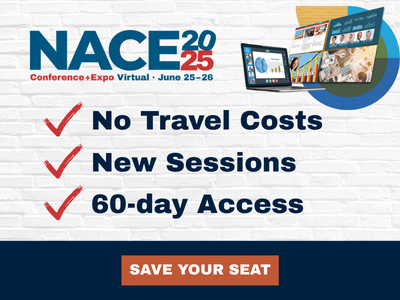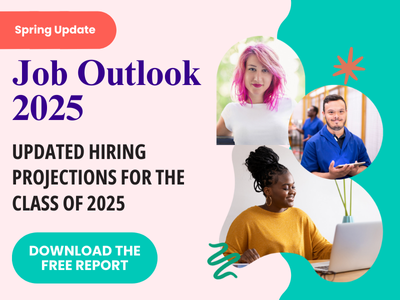A former dean now working with hiring organizations offers five lessons for how higher ed can work with industry and move the needle for students—especially low-income and first-generation students.
NACE Journal / Winter 2024
In January 2023, I transitioned from being the dean for academic innovation and career success at Guttman Community College, part of the City University of New York (CUNY) system, to join the New York Jobs CEO Council (Jobs Council). The Jobs Council is an organization committed to fostering collaboration among business, education, and community leaders to hire more low-income New Yorkers, with a focus on communities of color, into roles that pay a family a sustaining wage. My hope in moving to this position was that I could take the learning I had from 20+ years in higher education and use that knowledge and understanding to push for broader and more impactful change in how industry opens its doors to CUNY students. What I learned was how much change needs to happen on all sides of this equation.
Why This Career Move?
I turned 50 in 2022 and began to understand what a potential gift this moment in my career could be. I was reaching a peak of experience and knowledge in my field. I also saw that my career would be over in another 15 to 20 years, which gave me a sense of urgency to make the greatest impact possible at this phase of my career and my life. This urgency drove my career leap and my need to share as many lessons as possible in the first year of my transition as a fresh observer of the ailing connective tissue between higher education and industry.
What I Mean by “Industry”
I cannot tell you how often I used the term “industry” as a dean overseeing our career center at Guttman. This is a catch-all term, but I want to be specific here to give you a sense of the lessons learned and what type of industry they are true for so you can turn them into practice as soon as possible.
The industry I am referring to are the large corporations in accounting, technology, finance, and professional services that have massive hiring operations that engage with colleges to pull in talent on a very regular timeline. For the Jobs Council, this includes the largest employers in New York within the business and tech sector, such as Accenture, AIG, Amazon, American Express, AON, Bank of America, BlackRock, Bloomberg, Citi, Con Edison, Deloitte, EY, Google, IBM, JP Morgan Chase & Co., KPMG, Mastercard, McKinsey & Company, Microsoft, PwC, TD Bank, Travelers, and Wells Fargo.
I understand that some academic programs might not be interested in focusing too specifically on getting students hired into these particular industries; however, I encourage colleges to consider how to connect students to these companies where internships are paid and the entry-level roles pay a family sustaining wage to ensure those options are open to the students we serve.
Pulse Check on Career Prep in Higher Education
Having worked across four CUNY campuses in my career, both two-year and four-year colleges, I have seen the variable ways that career learning occurs at CUNY, and I have had countless conversations with CUNY students pre- and post-graduation to hear their experience of career learning. In the past several years, I have also been deeply involved in the initiatives coming out of the CUNY system office aimed at improving career preparation and outcomes for CUNY students. In addition, I am a diligent student of career preparation and workforce development research nationally. Based on that, here is my assessment of career learning in higher education at this point.
Challenges in higher education
There are a few large public higher education systems that have clear and consistent mechanisms for students to explore career pathways and prepare for their career success within the required curriculum. This is the only career learning worth discussion because, for students who are low income and/or first generation, extracurricular options for career preparation perpetuate systemic inequities.
Many campuses have first-year seminar courses that carve out a unit for career planning. Unfortunately, many first-year seminar courses are not required, or the unit is short and lacks critical elements, which leaves many students out of this make-or-break learning opportunity. Many campuses also have a variety of internship courses, but unless the course is required, participation is likely to be low. For example, the CUNY average for internship participation in 2021-22 was only 15%.
All CUNY campuses have career services centers, and in my experience working with this group of individuals at CUNY and beyond, these individuals bring critical expertise to their campuses. However, these offices are sorely underresourced with caseloads in the thousands and unreasonable expectations of internship management, a task that is incredibly complex. This reality is extremely frustrating to the professionals who get how important this work is and see how the lack of resources is a demonstration of the systemic inequities in higher education funding, particularly for minority-serving intuitions.
Bright spots
There are examples of campuses, such as LaGuardia Community College, that include a required first-year seminar that dedicates a significant amount of the course to career exploration and learning. This unit of the course was created in collaboration with career services professionals and includes topics like career exploration, career assessments, career preparation, e.g., development of resume, cover letter, professional pitch, and LinkedIn profile; and interview preparation. Additionally, every first-year seminar includes a student success mentor to offer guidance and support in this career unit from a near peer.
I also want to mention that working at Guttman Community College through much of my professional growth in this area demonstrated to me some of the key ingredients of integrating career learning into the curriculum. Guttman does so through required courses that are grounded in sociological perspective on the labor market and networking. The required spaces for career learning and preparation are dedicated to helping students develop the skills, knowledge, and competencies to knit together their academic experience with career planning and development. Guttman also has a faculty deeply committed to the success of their students above all else. Many faculty champion the integration of career preparation into the curriculum, and because of this, Guttman also has accomplished a faculty-led assessment process, which helped the institution align the college-wide outcomes with the NACE career readiness competencies to make them more transparent to students throughout their academic journey. However, this model has been difficult to support and expand within the broader CUNY context, though elements have been replicated and expanded at other large public colleges, including Bunker Hill Community College.

Lessons Learned
In the short time I’ve been senior director for career pathways, I have attended a dozen or so events that invite CUNY leadership, faculty, and students to experience industry from the inside. These occasions are held within the company offices and involve in-depth descriptions of what the company does, what types of jobs are available at the entry level, information about the interview process, and details about any special programs they have for engaging CUNY students. These events always include a CUNY alumni panel so alumni can offer their perspective about getting through the interview process, navigating their work-life at the company, and similar issues. This experience has woken me up. Here are the five lessons I have learned.
Lesson #1 – The resume is essential (and there’s more): I always knew that a resume was important. I often guided and supported resume workshops offered by the career services offices at the campuses where I worked. But seeing up close how this document acts as a gate keeper for students for internships and entry-level jobs, I think I would take a new approach to supporting its development if I had to do it all again.
I think there should be places throughout the curriculum where students are explicitly updating their resume by translating skills, knowledge, and experience in the classroom to relevant work experience on their resume. This first step is critical for low-income and first-generation students who may not have access to networks that can offer them an internship or job that will build their experience in the field—and their resume—in a job relevant to their career aspirations. A number of our member companies have also confirmed that you should include all work experience, including food service, retail, and childcare, which are ways that students can highlight career readiness competencies.
Including resume development as a part of the curriculum is, however, just step one of resume development. Step two is creating assignments and projects that help students practice how to speak to the elements of the resume in a way that positively represents themselves and their experience in an interview. In some of our events, we invite CUNY students in for some coaching and mock interviews, and I see a common issue that feels familiar. Students are uncomfortable talking about themselves, especially in a way that puts their most positive traits forward and points to their individual strengths and contributions in projects or work environments. This was also extremely uncomfortable for me in my early interviews. The only way I learned this was through feedback from colleagues and friends and practice. Therefore, I think we need to have assignments in required courses throughout the curriculum that explicitly ask students to practice this experience. One tool for doing this is the STAR method, but there are many if we just turn our focus toward this critical skill.
Lesson #2 – Get inside the specific interview process per company: Students need to understand the specific interview process, which varies per company, if they want to have the best chance of landing an internship or job. If colleges want to give students the best possible chance at nailing this critical step, they, too, need to understand the interview process and embed the information and preparation for this process into the curriculum.
In addition, students should be aware that they need to:
- Sign up for alerts to to get notifications for internship or job opportunities from companies;
- Learn the best practices for doing a virtual interview;
- Have experience with some of the types of assessments they may experience as part of the screening and/or interview process, such as a tech challenge or a test (such as the Plum) to assess their competencies;
- Know how much attention particular companies pay to a specific major and what might make them stand out as a candidate if their major is very different from the industry-preferred major.
Lesson #3 – Internships are early, and they are everything: The call to action for paid internships for greater career success for low-income students, students of color, and first-generation students has been loud and clear for some time. Unfortunately, the call has not been followed by the massive resources required to make this happen, especially in the large public colleges where the need is most critical. What I have witnessed in my time in this position is that the member companies we work with use their internships as their main source for hiring. This is supported by NACE research that 80% of employers indicated that internships provided the best return on investment (ROI) as a recruiting strategy, compared to career fairs, on-campus visits, on-campus panels, or other activities.1 So, if we want students to be hired into paid internships, it is critical to prepare them early—refer to Lessons 1 and 2—for internships that often require application in the sophomore year.
Lesson #4 – Sustained industry engagement is the only way to keep curriculum current: We often hear of the importance of industry engagement to keep curriculum current and relevant. There are some structures in place, such as program advisory boards or volunteer opportunities for industry professionals, that aim to engage industry. However, I have now seen that deeper and more sustained relationships with industry are the only way to ensure that curriculum is updated regularly to prepare students to get these kinds of industry jobs. Two examples of programs the Jobs Council has developed that accomplish this type of industry engagement are the College Apprenticeship Program, which shifts eight or nine credits at the end of an applied associate degree to the workplace, and our faculty fellowship in practice-based teaching and learning, which involves an intensive engagement between faculty, career services professionals, and our member companies. Additionally, we are in the process of collaborating with our member companies and the Business Higher Education Forum to create industry skills maps, which outline a set of knowledge and skills necessary to secure an internship, apprenticeship, or entry-level job in a particular job category, to share with academic programs for ongoing alignments. Colleges must start to prioritize and resource this deeper industry connection to make sure students are truly job ready.
Lesson #5 – The structures for change are emerging: My last lesson comes with an acknowledgement of how much change is needed on the industry side to change the ideas and structures in place that have kept so much of the talent out of the very jobs we are focused on at the Jobs Council. Part of what I see is that change management is very similar whether we are talking about higher education or industry. We have witnessed the commitment to change from the CEOs of the companies we work with, but we are aware that the change must happen in many layers before it turns into the impact the Jobs Council is committed to making. The last lesson, therefore, is that I have been pleasantly surprised by the deep commitment to this work on the industry side that point toward models for change. One example is that our member companies like Bloomberg and Accenture have created dedicated positions focused specifically on hiring from CUNY. Having a dedicated position has been a game changer for creating dedicated programs for CUNY that remove barriers and get significantly more CUNY students hired. Having such a position also leads to support programming for a more-inclusive work environment and opportunities for advancement. Many of our member companies are leading efforts to work toward skills-based hiring, and hiring students with associate degrees through our College Apprenticeship Program. The success of these programs serves as a proof point and is helping us scale up efforts and drive further positive change.
*****
My title at the Jobs Council is senior director for career pathways. This means that my job is specifically to repair the torn connective tissue between higher education and industry, specifically with the goal of advancing access and equity in the local labor market. In the short time I have been here, I am grateful to have learned so much that makes me hopeful for strengthening this relationship. I hope that the lessons I’ve learned and shared can begin to inform broader scale reform for career and professional development.
Endnotes
1 Winter 2022 Quick Poll on Spring Recruiting and Career Services. National Association of Colleges and Employers. Retrieved from www.naceweb.org/talent-acquisition/trends-and-predictions/winter-2022-quick-poll-on-spring-recruiting-and-career-services.







